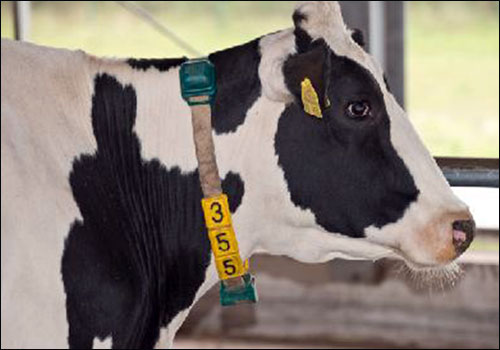Because the dairy industry is under pressure to increase its productivity and efficiency, German company GEA Farm Technologies has developed a radio frequency identification solution, known as CowView, to help farms manage their herds as if they knew each cow individually. Keld Florczak, GEA’s head of business development for cow health and farm management, described the solution at a May 1 breakout session at the RFID Journal LIVE! 2013 conference and exhibition, held last month in Orlando, Fla.
The consolidation of farms is resulting in larger herd sizes and dairy farms, Florczak explained, which can often result in increased labor or longer working hours. Growing human populations require greater output from dairy farmers. Due to the large herd sizes, farmers often have difficulty identifying each individual cow and tracking its health record. What’s more, farmers are under pressure to keep product cost low, thereby leaving a slim profit margin.

With these challenges in mind, GEA Farm Technologies—which manufactures technical innovations, integrated product solutions and animal-hygiene products for cost-efficient milk production—decided to develop a technology-based solution that would allow farms to reduce the amount of labor that would otherwise be required to monitor each cow and ensure her health. Instead, the company wanted to provide a system that would monitor animal behavior, in order to detect when a cow was in heat, moving around or lying down, as well as alert farm management when changes in these patterns were different compared with the behavior typical of that individual animal, or others within the same reference group. By providing this information and alerting farmers of changes in characteristic behavior, Florczak said, the solution could provide early indicators of an animal’s health, and thereby prevent illness or offer an early warning so that preventative actions could be taken.
While selecting a hardware vendor for the solution, GEA required tags that could identify a cow’s location within less than 30 centimeters (11.8 inches), for use by its customers—dairy farms and companies. It also sought to show the real-time movements of cattle within one second on smartphones or Apple iPads, which required a tag blink rate of 2 Hz (two blinks per second) or less. Additionally, the firm required a tag life of more than seven years.
In November 2011, GEA and Zebra Technologies conducted a proof-of-concept project in the Netherlands to verify that Zebra’s ultrawide-band (UWB) RFID tags and readers could provide the required location accuracy of 30 centimeters or better, as this was critical for the solution, based on the defined zones within the barn. Once those tests were completed, GEA put together the CowView solution, consisting of Zebra’s UWB tags and readers, as well as software developed by GEA.
Zebra’s UWB Dart RTLS tag, worn on a cow like a necklace, generates a very short RF pulse with a wide bandwidth signal at 6.3 GHz. It offers a long communications range—more than 300 feet, in fact, under conditions offering a clear line of sight between a tag and a reader. The solution can read more than 5,000 tags per second, and has a low power drain, thereby enabling a seven-year battery life.
The Dart transmits a unique ID number twice a second, says Adebayo Onigbanjo, Zebra Technologies’ senior product marketing manager, via a signal complying with the IEEE 802.15.4f standard. Zebra sensors installed on a barn’s ceiling receive that signal, he explains, and then forward the read data to the CowView software.
With the CowView software, farmers can view each cow’s location and behavioral data in real time, thereby helping them locate a specific animal when needed. The software also stores data regarding that cow, including its health and movement history, which could indicate her present health, or that she is going into heat—meaning she could be inseminated by a bull and thus begin producing additional milk. The cow’s movement data, along with that of her reference group, can also be compared with the animal’s movement history, in order to identify health or behavioral changes.
To date, the CowView system is being employed in Germany, the Netherlands and Denmark. According to Zebra, among the farms that have tested or deployed the solution is a Danish dairy farm operated by Asger Christensen. On that farm, the technology, including the mobile app, is being used to identify where individual cows are located when workers seek them.
GEA officially launched CowView at EuroTier in November 2012, and reports that it has already seen interest from within the European market. Further launches are planned in 2014 and beyond, to markets outside of Europe.


